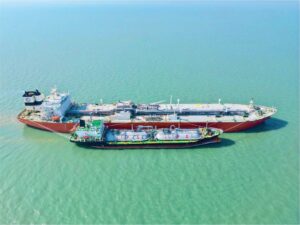8TH ISSUE
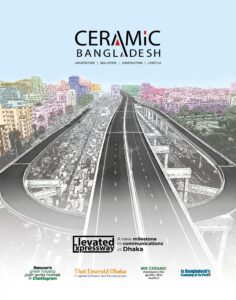
Elevated Expressway A new milestone in communications in Dhaka
The First Dhaka Elevated Expressway (FDEE) is called a ‘new milestone’ in communications and the project is being implemented under Public-Private Partnership (PPP) arrangement to alleviate traffic congestion in and around the capital. It has already been visible after inauguration of a portion of total of 46.73-kilometre-length with ramps, including a main elevated section spanning 19.73 km in the city. Prime Minister Sheikh Hasina inaugurated the 11.5 km part of it between Hazrat Shahjalal International Airport and Farmgate section, on September 2 with the key objective to shorten the lead time for exports and imports activities. Now people can travel the Airport-Farmgate site in 10 minutes thanks to the FDEE inauguration in the densely populated city. It often takes two hours to travel the 11.5 km due to severe traffic congestion. According to the First Dhaka Elevated Expressway Company Ltd, the total of 46.73-km-long elevated expressway is covering Airport, Kawla, Kuril, Banani, Mohakhali, Tejgaon, Magbazar, Kamalapur, Sayedabad, Jatrabari to Kutubkhali on the Dhaka-Chattogram highway. The entire expressway is expected to be opened for vehicles from Tejgaon to KutubKhali in June 2024. The FDEE project involves construction of a four-lane main carriageway and one elevated link road, comprising: four-lane dual main carriageway of a total length of 19.73 kilometers. It has a four-lane dual link-road carriageway of a total length of 3.1 kilometers. 32 on-off ramps including 16 on-ramps and 16 off-ramps (one-lane carriageway of 5.5 meter width) of a total length of 23.9 kilometers with 8 toll plazas and 43 toll collection booths. Besides the main four-lane dual carriageway and two suspended termini at its ends, it has five interchanges, two elevated links. The approximate total length of the main carriageway Expressway is about 46.73 km including 19.73 km main flyover and 31 km ramps and elevated links. Dhaka-Ashulia, Dhaka-Narayanganj and Dhaka-Chittagong expressways will also be connected with this elevated expressway in future. The project is one of the largest infrastructure projects taken up by the incumbent government spending a total of Tk 13,858 crore to ease traffic congestion. Of them, the cost of Airport-Farmgate section was Tk 8,940 crore. However, the FDEE project is being implemented under the PPP process between the government of Bangladesh, represented by the Bangladesh Bridge Authority (BBA), and the Italian-Thai Development Company Limited (ITD Group), represented by the First Dhaka Elevated Expressway (FDEE) Co. Ltd. According to the authority, around 80,000 vehicles can run on the FDEE a day. Chinese firm China Shandong International Economic and Technical Corporation, one of the three private partners of the PPP project, will operate the control centre. The FDEE is offlimits to three-wheelers and motorcycles. Other vehicles run on the structure at a maximum speed of 60km per hour in expressway and 40km per hour in ramps at the beginning. BRTC bus services commenced on the Expressway. The non-stop service, which began initially, runs with eight double-decker buses from Farmgate to the Airport. Road Transport and Highways authority said cars, SUVs, microbuses with fewer than 16 seats, and trucks with a capacity of less than three tonnes will pay Tk 80 for using the expressway. Trucks with six wheels will pay Tk 320, those with more than six wheels Tk 400, and buses with 16 or more seats Tk 160. Payment is being processed through e-ticketing. Local construction industries are thriving At least 10 local companies are making and supplying materials, such as cement, steel, stone and paint, for constructing the country’s first elevated expressway. Local products in place of imported alternatives are also being used in this mega project. This is not only saving foreign currency but also building the capacity of the local companies. A major portion of the Tk 8,940 crore project is being constructed using local materials. Of the 10 local contributors, six are cement companies while two are steel makers and the others make paint and PVC products. The cement makers are: Shah Cement, Crown Cement, Bashundhara Industrial Complex, Heidelberg Cement, Seven Rings Cement and Premier Cement. The BSRM and GPH Ispat are providing steel for the project while two concerns of RFL Group — RFL Pipe and Fittings, and Rainbow Paints — are supplying necessary pipes and road marking materials. RN Paul, managing director of RFL Group, said they are providing waste and rainwater pipes and fittings for the drainage system of the elevated expressway as well as road marking materials. Mr Paul explained that if local companies do not provide the required construction materials, then they would have to be imported at the cost of huge sums of foreign currency. “So, local companies benefited and also the process helped save foreign currency through such cooperation,” he said. Till September 2023, a total of 66,000 tonnes of steel has been used in the elevated expressway project, with BSRM contributing a majority 52,000 tonnes (80%). Tapan Sengupta, deputy managing director of BSRM, acknowledged that involvement in this type of large project helps local construction material companies grow their capacity and achieve global standards. Sheikh Masadul Alam Masud, founder chairman of the Bangladesh Steel Manufacturers Association, said the local steelmaking capacity has nearly doubled to about 9 million tonnes over the past decade. Local cement manufacturers have increased their production capacity to 6 million tonnes per annum while it was 2 million tonnes annually just 10 years ago. Back to history In January 2011, the certificate authority (CA) was signed between Bangladesh government, represented by Bridges Division, the Ministry of Road Transport and Bridges, acted through Bangladesh Bridge Authority (together the “grantor”), and First Dhaka Elevated Expressway (FDEE) company limited (the “concessionaire”). The ITD, the largest construction company in Thailand, established first Dhaka Elevated Expressway Company Limited (“FDEE”) as a 100%-owned special purpose vehicle, registered in Bangladesh, to accede ITD as the concessionaire in the concession agreement for implementation of the project. The BBA signed deal with Italian-Thai Development Public Company to build the FDEE at a cost of Tk 8,703 crore in January 2011. The agreement was revised and inked again in
Read More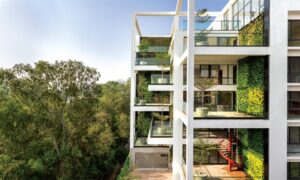
Rancon’s green housing push works marvels in Chattogram
Imagine a time when greenery and what is called green growth were everywhere with the touch of green fingers. Unfortunately, we have to paint a picture in our mind to relish the green landscape of the past. Unlike in the countryside, greenery is like an oasis in the midst of concrete jungle in this time and age. Now, towns people have to escape to a distant village in the hope of relishing a piece of green nature. Greenery and foliage are fast losing out to modernity, urbanisation, and industrialisation. The port city of Chattogram is no exception. This city now abounds with bricks and mortar, stones, and concrete walls that green activists regard as a concrete jungle. If you stand on the balcony or peep through the window, it is hard to see even a piece of the sky. There was a time when a flower garden was an absolute necessity in the courtyard. Also, there used to be a fruit or vegetable farm in the backyard. However, it is time to return from the flashback to the present, as those things of the past are revisiting the urbanites through Rancon FC Properties Limited RFCPL‑. The realtor is working relentlessly to develop sustainable green structures, for both residential and commercial purposes in the port city to feed the growing customer demand for healthy and environment-friendly apartments. The city development authority has mandated setbacks in design to make the home environment healthy. If a building is designed according to the setback, it is sure to have space in front and back in proportion to the size of the land. As a result, it is possible to maintain adequate sources of light and air after the building is constructed. The RFCPL began its journey in Chattogram back in 2010 with an eye toward managing accommodation for the city’s growing population. However, the property developer changed its business philosophy in 2018 as it aspired to create innovative designs, maintain the finest building quality, and establish sustainable living through its creative green establishments.Since its inception, the RFCPL has been transforming the skyline of Chattogram with superior landmarks. It has an array of commercial and residential projects in various central locations such as Agrabad, Khulshi, South Khulshi, Nasirabad, Katalgonj, Halishahar, Mehedibagh, and Panchlaish. The real estate leader has always pledged to ‘Explore Excellence, and, as such, it has strived to keep its promise to meet clients’ expectations of an abundantly green living space. Tanvir Shahriar Rimon, CEO of Rancon FC Properties Limited, says his company attaches great importance to environment-friendly housing as the changing climate patterns, mostly due to reckless human interventions, are impacting lives and livelihoods across the world. “Our company aims to create lifestyles at all stages of the process, from design to construction and beyond. It has set the benchmark for premium commercial and residential real estate in Chattogram. The RFCPL is the optimal choice for customers’ real estate demands in the port city. Each of our projects includes rooftop solar and rainwater harvesting systems. Apart from that, the building is made only after leaving enough space as per the setback to maintain the complete system of light and air,” he pointed out. RFCPL attaches great importance to environment friendly housing as the changing climate patterns. Building temperature is less than 2.0-3.0 degrees celsius than any other buildings in the country. He added, the company is crafting the art to uphold the vertical landscape in different projects, one of their specialities and attractions. Building temperature is less than 2.03.0 degrees Celsius than any other buildings in the country, thanks to use of green materials in line with their green policy, he pointed out. Major Features of Rancon Projects Green materials and equipment, renewable energy, energy-efficient technology, automation, water recycling, rainwater harvesting, and curbing the waste of building materials are the key features of Rancon’s projects. Every unit has natural light and ventilation. A green entrance and water fountain have been set up. Many buildings have special fire hydrant facilities. In the case of any fire incident, there are two types of systems: detection and prevention. Apart from home automation systems, there is a video intercom system and 24-hour security. Wi-Fi facilities are also there in many compounds. Several elevators, as well as generators, are available. Inspace, another concern of Rancon, is designing all of the projects. Wahidur Rahman, Inspace CEO, and principal architect, told Ceramic Bangladesh that international standard design, modernity, and aesthetics have been combined in all of their building projects.Additional facilities are available for exclusive projects. Facilities include, multiple basements and open ground floors with parking, reception, waiting area, gym, prayer space, community space, driver’s lounge, and laundry. An adequate green system has been built, Mr. Rahman pointed out. Eco-friendly Projects Chattogram city has been facing various problems in recent decades, such as a lack of green space, recreational facilities, and disasters. So, the RFCPL is running a total of 23 projects related to commercial and residential schemes with its green goal. White Oak White Oak, handed over recently as a green project, boasts an exquisite oak theme and is the first of its kind in Chattogram. The rainforest welcomes a visitor at the entrance. Three different lounges were purposefully made to engage the community, while space for a gymnasium and a mindfulness zone reduce stress and have a positive impact on the mental health of the dwellers. This white structure, standing sublimely in the tranquil Mehedibagh Residential Area, has not only transformed the surrounding area but has also revolutionised the lifestyle of its inhabitants. The RFCPL’s main objective of “Creating Lifestyles” has been achieved through this holistic approach. Park Terrace Park Terrace is another project that the RFCPL has recently handed over to its sophisticated clients. It was designed to foster a sense of calm and well-being with thoughtful features that promote relaxation, focus, and connection. From the serene vertical garden and meditation place to the lush rooftop terrace spaces, they are carefully crafted to enhance
Read More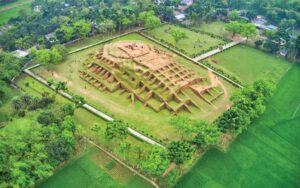
Mahasthangarh the Cultural Capital of SAARC
At times when we get tired of the city’s dust, chaotic traffic, and hectic jobs; we might want to step outside its orbit and get some fresh air with a touch of greeneries and nature or want to get closer to history and tradition. Bangladesh, despite being densely populated country with compact horizon, still stands proud on the global map with its rich heritage and significant tourist attractions. Mahasthangarh, the earliest urban archaeological sites and the oldest-known city, is one such must-visit tourist spot for both the historians and the travelholic people. Before the birth of Jesus Christ, i.e. about 2500 years BC, the civilized town was established here. Archaeological evidence has been found. It is located in Shibganj upazila of Bogura district, lying on the western bank of Korotoa river, about 13 kilometres north of Bogura city on the Dhaka-Dinajpur highway. Once Mahasthangarh was the capital of Bengal. It was declared the Cultural Capital of SAARC in 2016. An interesting fact about Mahasthangarh is that it is also a flood-free physiographic unit because of the elevation of 15-25 meters above the surrounding lowlands, which makes it an even exquisite historical tourist spot. It is believed to be the main reason for urban development here as it is one of the highest regions in Bangladesh. The land here is 36 meters (118 ft) above the sea level, while Dhaka, the capital of Bangladesh, is only 6 meters (20 ft) above sea level. Another reason for choosing this place is the location and shape of Korotoa river. The river in the 13th century was three times wider than the present Ganga. Mahasthangarh is located in the red soil of Varendra region which is slightly higher than the alluvial region. Areas above 15-20 meters are considered flood-free geological zones. Mahasthangarh the most significant Buddhist archaeological site, was a thriving administrative, religious, and cultural centre from the Mutual Empire era to the Sen Dynasty era. Initially, the location was known as Paundravardhanapura or Pundranagara, both of which are references to the Pundra Kingdom from Indian epic literature, which was claimed to rule over a region of India, now known as Bihar. A broken limestone slab from the 3rd century BC that bears six lines in ‘Brahmi’ script has been found there with the name ‘Pundranagar’ inscribed on it. The walled city has archaeological monuments from different periods. For several centuries this place was the provincial capital of Maurya, Gupta, Paal, Sen rulers and later the capital of Hindu feudal kings. Numerous Hindu kings and kings of other religions ruled from the third century BC to the fifteenth century AD. Hazrat Shah Sultan Mahmud Balkhi (RA) and his disciples came to spread Islam in this area. There is an amazing legend about the preacher Shah Sultan Balkhi. It is said that he crossed the Korotoa river on the back of a huge fish-shaped boat while entering Mahasthangarh i.e.ancient Pundranagar. The famous Chinese traveler Hiuen Tsang visited Pundranagar between 639 and 645 AD. In his travelogue he describes the nature and lifestyle of the time. Being famous for Buddhist education, monks from China and Tibet used to come to Mahasthangarh to study. Then they went out to different countries in South and East Asia. There they spread the teachings of Buddhism. The topography of the place offers a fascinating cubicle-like view. The entire area is surrounded by a fortification wall. The rampart of the city, built with burnt bricks, belongs to six building periods, among which the earliest belonged to the Maurya period. Various mounds and monasteries (bihar) are scattered throughout the vast area outside the fortification wall including Bairagir Bhita, Govinda Bhita, Khodar Pathar (stone of Allah) mound, Mankalir Kunda mound, Jiyut Kunda (Well of Life), Godaibari Dhap, Noropotir Dhap, Gokul Medh (Lokhindorer Bashor Ghar), and Bhasu Bihar. One of the highlights of Mahasthangarh is Govinda Bhita, where remnants of two Buddhist temples can be visited. Opposite Govinda Bhita, near the north side of the citadel, one can find the Mahasthan Archaeological Museum. The museum, though small, has a well-maintained collection of pieces recovered from the site including the statues of Hindu and Buddhist gods and goddesses, terracotta plaques, fragments of ceramics, well-preserved bronze images found in nearby monastery ruins that date back to the pre-Paal period. Gokul Medh Buddhist monastery, located about two kilometers south-west of Mahasthangarh, belongs to the most impressive archaeological sites in this area. Behula Lakhindorer Basor Ghor Behula is the protagonist in the Manasa Mangal genre of Bengali medieval epics. A number of works belonging to this genre were written between the thirteenth and eighteenth centuries. Though the religious purpose of these works is to eulogise the Hindu goddess Manasa, these works are more well known for depicting the love story of Behula and her husband Lakhindar.
Read More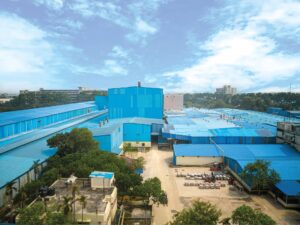
MIR CERAMIC Dominates The Quality Tiles Market
Mir Ceramic Limited (MCL) is one of the largest, prominent ceramic and porcelain tile manufacturers in Bangladesh. The most trusted tiles manufacturer was founded in 2001 and began commercial production in 2002 with the globally acclaimed Italian brand SACMI’s state-of-the-art machinery, widely acknowledged as the best ceramics manufacturing equipment provider in the world. Mir Ceramic is a proud member of Mir Group of Companies, one of the oldest and highly reputed conglomerates in Bangladesh. The Group began its journey in 1968 as Mir Akhter Hossain Limited (MAH), the iconic construction company in Bangladesh. The group has diversified into real estate, banking, telecommunications and ICT industries. Mir Ceramic produces a range of high-quality products such as porcelain tiles, ceramic wall tiles, granite floor tiles, homogenous stair tiles, and industrial tiles. One of their most popular products is the Mir polished tiles, which are renowned for their exceptional durability and smooth finishing. It has a production capacity of 90,000 square meters of tiles per month. Proudly promoting ‘Made in Bangladesh’ with a combined workforce of 2,000 local craftsmen and artisans for manufacturing. Mir Ceramic Ltd prides itself on its commitment to quality and customer satisfaction. With a team of experienced professionals and the latest technology, they strive to deliver the best possible products to the customers. The company is constantly innovating and expanding its product line to meet the changing needs of the market. Skilled Manpower, Innovation, World-Class Machinery and Raw Materials are behind the Success As one of the leading ceramic and porcelain tile manufacturers, Mir Ceramic Ltd has established a strong reputation for excellence in the industry. Its products are highly sought after by builders, architects, and homeowners alike, who appreciate the quality, durability, and style that the company delivers. Mir secures the highest quality raw materials from across the world, including Spain, Italy, Malaysia and Thailand. MCL has assembled an expert production team, with decades of experience in the industry, to oversee manufacturing. As a result, Mir Ceramic produces tiles with the highest bending strength and lowest water absorption in Bangladesh. Consistently producing superior quality tiles for over so many years has helped establish Mir as a dominant player in the upscale tiles market in Bangladesh. Mir Ceramic’s vision is to create a world where those who won’t settle for anything but the best can proudly use tiles made right here in Bangladesh. MCL is committed to producing the strongest and longest lasting tiles in the country by continually adopting the latest manufacturing technology and sourcing the very best raw materials from around the globe. MCL takes a customer centric approach to product development, by continually engaging customers and technology partners to develop products that meet the evolving needs of the discerning clients. MCL aims to achieve growth while continuing to be environmentally responsible. To achieve this, the company continually leverage the latest technologies to increase the efficiency of manufacturing and energy generation processes and captures and reuses energy, waste raw materials and water. Manifold regulations are key hurdle for local and foreign investors “Once the use of ceramic products in Bangladesh was comparatively low. This was due to low purchasing power of people and high cost of ceramics products at the time. Earlier, the country was heavily dependent on imports spending huge amounts of foreign currency. This inspired the Group to enter the tiles manufacturing business in 2001. By producing tiles locally, we saw an opportunity to not just to reduce import dependency but also value add and create well-paying jobs,” Ruslan Nasir, Deputy Managing Director of Mir Ceramic Limited (MCL), told the Ceramic Bangladesh magazine. He said, once upon a time, there were only a handful of companies producing tiles in Bangladesh. Most tiles produced locally were unable to meet international standards. Mir Group established MCL with a clear objective: to make the strongest and longest lasting tiles in Bangladesh. Since its inception, Mir Ceramic has utilised Italian manufacturing equipment. MCL secures only the highest quality raw materials. Ruslan Nasir said, “Mir has played a pioneering role in the manufacture of quality tiles by being the first local company to utilise European machinery. From day one, we were very serious about the quality of our products. This helped establish Mir as one of the largest and most trusted tiles manufacturers in Bangladesh. Till date, Mir Ceramic is the only ceramics company to be awarded the prestigious President’s Industrial Development Award.” “However, the company faced many challenges in the early days. One of the greatest challenges was the lack of skilled manpower at that time. Mir invested heavily in skill development, through a combination of hiring workers with international experience and hiring foreign trainers to develop local talent. Skilled manpower development, combined with world-class machinery and raw materials, helped Mir Ceramic bring tiles of international quality to the Bangladesh market.” In the last 10 years, the ceramics sector in Bangladesh has experienced phenomenal growth. Today, locally made high-quality ceramic products are more readily available in the country. Recent studies reveal that local capacity is now capable of fully meeting the demand and accounts for over 80% of local consumption. Local manufacturers are benefiting from economies of scale thus driving down prices. This has made locally made ceramics products affordable to a larger segment of the population. As a result, the ceramic sector in Bangladesh has grown 200% in the last decade, creating 60,000 jobs directly in the process and 5,00,000 indirectly. Founder of Mir Ceramic Ltd. and Managing Director, Mir Nasir Hossain is a leading business figure of Bangladesh. He has served as President of the Federation of Bangladesh Chambers of Commerce and Industries (FBCCI), the apex trade organisation. He established Mir Ceramic with a clear objective of producing the strongest and longest lasting tiles in Bangladesh. As Managing Director of Mir Telecom Ltd., Mir Nasir Hossain has received the National Export Trophy (Gold) from the Prime Minister of Bangladesh on multiple occasions. However, the industry has faced significant challenges in recent times which could threaten
Read More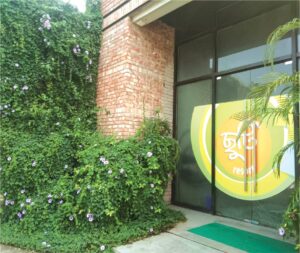
Chuti Resort An Escape from Chaos
‘Chuti’ is a famous juvenile poem by Nobel Laureate Rabindranath Tagore. Bengali ‘Chuti’ means vacation, rest. Take a break from busy work. Some time to laugh, play and enjoy. The Chuti Resort was built from that spirit. If you are looking for an escape from the hustle and bustle of city life and to immerse yourself in the serene beauty of nature, Chuti Resort can be your perfect destination. Nestled beside shimmering Lakes, Chuti Resort provides an idyllic backdrop for a rejuvenating getaway. It is dedicated to offering a top-tier eco-friendly lifestyle experience in Bangladesh. Situated near Bhawal Rajbari, 18 kilometers from Dhaka Airport, this resort is in Sukundi village on the eastern side of the Gazipur, a meagre three-kilometre from the renowned heritage site Bhawal Rajbari and Bhawal National Park. Conveniently accessible by road, it takes approximately 1 .5 hours to reach the main destination from Dhaka. Spanning 17 acres of lush greenery, Chuti Resort is committed to highlighting Bangladesh’s rich natural and cultural heritage, promising guests unique and authentic experiences. As one embarks on a journey through this resort, s/he can explore the myriad features and amenities that make them truly exceptional, from serene Lake and inviting decks to whimsical treehouses, engaging Kids Zones, refreshing swimming pools, and luxurious suites. Breath taking views of surrounding lake water and wildlife in amazing natural beauty of land covered with dense green blanket of flora makes anyone feel like enjoying the country’s natural heritage. In this peaceful and tranquil environment, you can have the glimpse of wildlife, firefly processions at night and according to the rules of the resort, during moonlight no light is lit in outside. It is one of the best holiday destinations to enjoy the full moon and rain in the rainy season; also to breathe in the fresh air. Central Lake is the heart and soul of this resort, serving as a serene focal point that encourages relaxation and reflection. Chuti Resort is nestled at the center of a forested oasis and the lake creates an atmosphere of tranquility. Guests can enjoy the gentle symphony of croaking frogs and chirping crickets as they sip their morning coffee on the deck of their cabin or lounge peacefully beside the water’s edge. The lake also provides opportunities for a variety of activities, such as catch-and-release fishing, where guests can try their hand at landing a variety of aquatic species, adding an element of adventure to the serene landscape. Eco-Friendly Boutique Resort Chuti lodges facility that takes steps to reduce its carbon footprint while giving back to its local community. Some of the best ways that they practice to make the resort more eco-friendly and sustainable, maintain energy saving, limit water waste, have guests reuse linens, equip staff with eco-friendly cleaning staff, serve local and organic food. “Accommodation in nature resorts is thoughtfully designed to offer guests an immersive experience while ensuring maximum comfort.” Advocate Mostofa Mahmud Arifee, the chairman of Chuti Resort said adding, “Perched near lakes, these enchanting sanctuaries offer a one-of-a-kind connection with the natural world.” There are 50 rooms with several types of accommodation facilities such as Cottages, Royal suites, Villas with luxurious bathrooms, and private decks with breathtaking views of the surrounding landscape. Falling asleep to the rustling leaves and waking up to the melodic songs of birds is an unforgettable experience. Families with children are warmly welcomed at nature resorts, where they have dedicated Kids Zones designed to engage and entertain the youngest guests. These imaginative spaces are created to introduce children to the wonders of the outdoors in a fun and educational manner. Playgrounds, nature-themed activities, and hands-on programmes encourage kids to explore, learn, and develop a deeper appreciation for the environment. There is a treehouse making a favourite space for kids to play and spend time. It’s in these Kids Zones that young adventurers can discover the thrill of discovery and the joy of connecting with nature. Chuti Resort’s allure is further enhanced by the inviting swimming pool. This refreshing facility provides guests with a cool respite on a sunny day, inviting them to relax and rejuvenate amidst the beauty of the natural surroundings. After a day of basking in the tranquility of the outdoors, a dip in the pool is the perfect way to unwind and savour the memories created throughout the day, adding an extra layer of luxury to the experience. Advocate Mostofa Mahmud Arifee Chairman, Chuti Resort When it comes to dining, Chuti Resort offers farm-to-table experiences that celebrate the flavours of the region. Fresh, locally sourced ingredients are transformed into delectable dishes that are as much a feast for the eyes as they are for the palate. Guests can indulge in culinary delights while dining al fresco on outdoor decks, where the soft babbling of the nearby pond and the gentle rustling of leaves create a harmonious symphony of sensory delight. The experience is further elevated by the opportunity to dine under the stars, adding a touch of enchantment to every meal “In Chuti resort we provide Pleasant for couples and families, corporate meetings and workshops, Cottages, and suites to accommodate Modern restaurants serving delicious foods and Authentic recreation in a village environment,” Advocate Mostofa Mahmud Arifee mentioned. Chuti Resort is a magical sanctuary where guests can disconnect from the pressures of the modern world and rediscover their profound connection with the natural world. Whether one is basking in the serenity of a picturesque pond, finding enchantment in a luxurious treehouse suite, watching children explore the imaginative Kids Zone, taking a refreshing plunge in the inviting swimming pool, or savouring farm-to-table dining on a scenic deck, this resort offers a tapestry of experiences that pay homage to the beauty of nature. Chuti Resort serves as a reminder that in our busy lives, the wonders of the natural world are always ready to embrace us, providing solace, adventure, and a deep sense of wonder that leaves an indelible mark on our souls.
Read More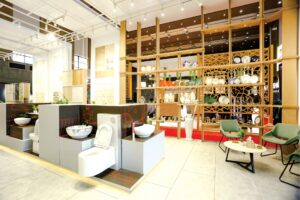
AKIJ CERAMICS BRINGING PERFECTION
Ceramic Expo Bangladesh, 2022 was a magnificent event for the Ceramic Industry with participation of all the key players in the ceramic market. It was an event for business interaction and social gathering of the ceramic industry that brought all the ceramic manufacturers, foreign raw material suppliers, importers, buyers, dealers, architects and common visitors under a single roof to enjoy a world class exhibition experience and see state-of-art ceramics. It was a 3-day-long celebration of the exhibitors and visitors to explore the ceramics world. With the tagline ‘Promise of Perfection’, Akij Ceramics Ltd. patronised the 3rd Ceramic Expo as the Principal Sponsor. The company had sponsored the event for the 3rd time in a row which was a grand event of the ceramics world in Bangladesh. The largest ceramic brand of the country showcased its tiles, tableware and sanitaryware in the event. Under the name of Akij Ceramics the company displayed its tiles under Akij Ceramics & AURA, tableware under Akij Tableware and sanitaryware products under the brand of ROSA in their pavilion at Hall 4 of Novoratri at ICCB. They showcased all the new innovation and products to attract their customers and make them aware of their product range. It was a great opportunity for the organisation to showcase all of their brands under a single platform and interact with their business partners, suppliers, dealers and fellow companies under the same industry. With the gracious presence of 23,000+ visitors the event has positively impacted on the business. In the event of Ceramic Expo, the prime goal of Akij Ceramics was to bring the new products of all the tiles, tableware and sanitaryware segments. The company is looking forward to reducing import of ceramic products by boosting economic growth and development of the industry. The iconic business leader of AkijBashir Group, Mr. Sk Bashir Uddin along with the brand managers and company representatives were present at the event. The Pavilion was the biggest of all and they had decorated it with their products to present to the target customers and created their own unique impression among the crowd. All the visitors were mesmerised with their product collection and variety and also interacted with the company people present there. Mr. Mohammed Khourshed Alam, Director Operations of AkijBashir Group, expressed enthusiasm about ceramic expo in an interview and their expectation from the overall event was to show their brand strength and collect feedback from the customers. To connect with the visitors more actively, Akij Ceramics provided special offers on spot orders in the expo, instant gift packs and also provided gifts for the social media contest winners. At the event famous celebrity actress Bidya Sinha Saha Mim graced the event with her presence on the second day of the expo. The visitors had enjoyed the meet and greet session with Bidya Sinha Saha Mim and she enjoyed her visit to the pavilion and explored products of Akij Ceramics to explore uniqueness of the brands to promote the best products of the company. In the Ceramic Expo Bangladesh, 2022 under the category of best pavilion, Akij Ceramics Ltd. was awarded with second prize on the Exhibitors Night in the Jury Board Choice Award. The award was presented based on well scale, openness, visitor friendliness, product display etc. Akij Ceramics always believes in perfection that comes with the impression of revival, renewal and diverse innovations in their product design, quality, elegance and uniqueness. It was a great experience for them to become the principal sponsor at the event and explore new business opportunities along with world class experience of displaying ceramic tiles, tableware and sanitaryware to the visitors of home and abroad. AkijBashir Group thanked BCMEA, organiser of the event for such an impressive arrangement of the event and expects to have even better event arrangement in upcoming years. Written by Preety Dey
Read More
How bKash Empowers People Thru Financial Inclusion
bKash, a mobile financial services (MFS) provider in Bangladesh, is operating as a subsidiary of BRAC Bank Limited, under the authority of Bangladesh Bank. bKash has been providing fast, secure and convenient services via mobile phone to its more than 70 million verified customers for the past 12 years, authorities say. These customers transact more than Tk 20 billion every day. Only recently, people had to wait in long queues in the morning just to pay utility bills. And almost no financial services could be accessed from home comfortably. However, gone are those days, thanks to MFS providers like bKash. Now, millions of people no longer need to worry about paying bills or fees, doing savings, taking small loans or even receiving remittance from abroad – all these are now a matter of a few taps. MFS has evolved into a common platform for availing various financial services. As a result, the hassles people used to face earlier while seeking financial services are now considered a thing of the past. Financial services have reached the fingertips of people from all strata, making life easier. The dependence on digital transactions thereby increased manifold. It’s not just a means of sending money or paying bills anymore. It has become a complete financial service platform with a variety of financial products including merchant payment, savings, nano loan, remittance from abroad, bill payment and mobile recharge. It has become a part of lifestyle. bKash is now a member of every family in weal and woe. Though some other MFS providers have launched similar services, the term “bKash me” in the MFS arena is now the word of mouth that simply denotes money transfer. In its 12 years journey, according to the authorities, bKash has built the strongest network of 3,30,000 agents, commonly called as “Human ATMs” to take mobile financial services to the doorsteps of people in every corner of the country. These agents have not only succeeded in serving customers, but also been able to improve the living standard of their own families. Other MFS operators who came later, took leverage of this distribution channel established by bKash to reach customers. Bangladesh Bank, the regulator of this industry, has had proper guidance and policy support to help MFS flourish and become customers’ trusted partner for daily transactions. Besides, bKash’s service quality, continuous investment and innovation played pivotal role in garnering the trust of custromers. Of its 70 million user base, more than 45 per cent customers are female. Customers can avail its services such as cash deposit, cash withdrawal, money transfer, top-up, remittance, mobile recharge, payment and bill pay by dialing *247# and using Bkash app. To open an account a customer has to fill the prescribed customer registration form (KYC) with complete details. If the money goes to the wrong number it should be reported to 16247 immediately. bKash started operating as an MFS provider under the license of Bangladesh Bank on 21 July 2011 to cater financial services through mobile phones. Catering to people’s daily transactional needs with secured and time-saving solutions, bKash is empowering them to fulfil their dreams as well as taking the country forward During this time, bKash has brought the unbanked and underserved population into financial inclusion. Be it from a remote village or a small village market or a trading centre, a large number of customers has been connected to the formal financial channels through bKash. Currently, a total of 44 commercial banks are connected to the largest bank integration network of bKash. Thanks to seamless money transfer between bKash and banks, customers’ experience has radically changed, the authorities told the Ceramic Bangladesh. Earlier, going to a shop was the only way of recharging mobile phone numbers. In the span of an era, topping up all operators’ mobile numbers through bKash has become the most preferred way for millions of people in Bangladesh. A mountain of hassles for paying just a small amount of utility bill was a common place before. Now bKash has made all kinds of utility bill payment for electricity, gas and water easier for the common people. Besides, fee payment of many government services has become a matter of a few taps, they said. Since 2017, bKash has successfully disbursed allowances and stipends to around 10 million beneficiaries of many government initiatives and safety net programmes including primary education stipend, the Prime Minister’s Covid-time financial assistance, farmers’ incentive allowance under the Ministries of Agriculture, Fisheries and Livestock, maternity allowance, the Ministry of Disaster Management and also the salary, allowances and incentives of workers of the export-oriented industries. Bangladeshi expatriates from around 90 countries can send remittances through 80 international money transfer organisations via settlement in 17 local commercial banks. In 2022, nearly Tk 40 billion worth of remittance came to Bangladesh through bKash. Savings through bKash has also become very popular among the people. So far, around 1 .1 million customers have availed the savings schemes through bKash app. The hassles to save small amount of money is now gone due to such service. Not only ‘Savings’, digital nano loan can also be availed through bKash app. bKash, in association with The City Bank, introduced the country’s first-ever Digital Nano Loan in 2021. With this innovation, eligible bKash users can avail a loan ranging from Tk 500 to Tk 20,000 through bKash app. In the meantime, digital loan of Tk 3 billion has been given for a period of 3 months. bKash services save times, relief hassles Proprietor of M/S Taqwa Ceramics at Hatirpool Mohammad Zahid Hossain said, “Many customers want to make payment now after purchasing ceramic products through bKash as it saves their time and reduce other hassles. At the same time, it saves us from risk of handling counterfeit notes.” The digital transaction in business and other payments is going up day by day. As a result, the demand of bKash services increased as well. Another trader, Imran Hossain, manager of Ammar Sanitary of Bangla Motor, said they
Read More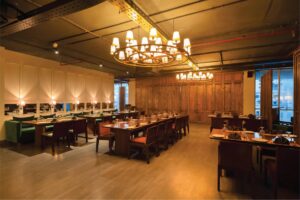
Thai Emerald Dhaka A Myriad Of Browns And Blended Greens
It’s a cosy Thai restaurant that transports one into the cultures and feels of Thailand through its rustic approach and earthy colour palette. So, be prepared to feel the vibes of Thailand and enjoy the warm atmosphere with a great dining experience. Most people know Thai Emerald as a go-to place to enjoy good Thai cuisine. Since its inception in 2012, Thai Emerald has strived to bring the flavours of Thailand to Dhaka – from Uttara to Gulshan to Dhanmondi – through its design and food. It has progressed over the years. Architect Rafia said their goal was to reflect the food served and the geographical setting of the restaurant while making the design. During the design of this restaurant, she used furniture and earthy tones similar to what she did with other restaurants to connect the brand and have a sense of reconciliation with the other two restaurants in town. A few of the dining chairs and the reception table and cash counter with the lotus motifs were elements that she had replicated to harmonise it with its predecessors. The wooden blocks situated on the backdrop of the cash counter pay homage to the second branch of Thai Emerald situated in Gulshan. The space was designed with efforts to keep the restaurant spacious to better accommodate large groups of people that frequent the restaurant. This was further highlighted by creating soft visual partitions through perforated separators or more solid partitions that allow big groups to co-exist with individuals or small groups while dining simultaneously. The architect wanted the diners to have elements to explore while dining at the restaurant – large cluster of doors separating private rooms, mirrored backdrops, or lamps hanging from the walls. The diners would have unique visual characteristics to ponder. She envisioned that people should be able to properly enjoy their time there. Thus, her goal was to create a warm, inviting ambiance with a play of dimmed, hand-crafted lights and splashes of earthy tones to create a soothing, delightful atmosphere for the customers. A focal element for this particular restaurant would be the doors, enclosing the private rooms, designed to be a point of attraction. “The reflection of Thailand is brought in through elements; for example, the lotus motifs in the door handles are a direct reflection. If you see Thai design, you’ll notice the use of softer lines rather than harsh straight lines, which have been reflected in the use of curved lines in the door details with softer, rounded edges,” the architect explains. Designing the small doors and playing around with the depth and lines was an interesting element that she loved when working on the restaurant. The architect wanted the doors to intrigue onlookers instead of having a dead space with boring partitions. In keeping with modern, contemporary design, the perforated partitions are made of sleek frames and thin lines to have a stylish outlook. A lantern of ‘Beth and Chatai’ was carefully designed and crafted in the escalator zone near the entry to give passersby and incoming guests a taste of what unfolds inside. The lantern, which was a focal point, was an experimental design by the architect to challenge the bounds of what could be made with flowy waves instead of the traditional circular design. The architect also worked with multiple local artisans to create custom-designed hand-crafted lights and chandeliers made of local materials like cane, wood, bamboo, and beech. The service corridor is lined with basket-shaped hand-woven lamps that lead people into the restaurant. A mix and match of kerosene wood, gorjon wood, and plywood were used to form the wooden elements displayed in the restaurant. An essential portion of the design was focused on creating a curated colour palette of browns and greens with a touch of grey to avoid having any harsh colours and instead opt for a homogenous, complimentary, soothing colour palette. The earthy tones are further accentuated by using browns that have grey undertones so that the overall output looks well-groomed. Grey texture paint was used to highlight a wall; it includes a chamfered rectangular punch that allows a visual connection with the service corridor. “We decided, deliberately, not to use any blinds on the windows; I want the existing floor-to-ceiling windows to let in ample daylight during the day so that customers can enjoy the sun, and it also gives a spectacular view of the city during the night, “the architect said when asked about keeping the floor-to-ceiling glass windows open. She added that they have not yet had any problems regarding heat gain from the facade. A signature personal style that the architect incorporated into the design was variation in designs of the door knobs used extensively throughout the space. Starting from the door handles of the private rooms, they feature lotus halves, so when closed, they form a full lotus. The door handles were placed much lower than the standard height to create a varied look when all the doors are closed together. The door handles of the restaurant doors have linear wooden handles on glass doors, and the toilet door handles are curved inward to create a unique motif. The restaurant of Dhanmondi, too, has two entrances to cater to both lifts on opposite sides leading to the restaurant floor, a fact unique to this restaurant. The ceiling is left open to have a modern industrial feel and is painted grey to match the vibe of the restaurant, with only a thin red line of the sprinkler system showing up on the ceiling as a touch of colour in accordance with the building safety regulations. A large painting of an elephant is hung on one of the feature walls as an homage to not only the heritage of the restaurant but also to tie bits of Thai cultural elements into the atmosphere. As you enjoy dinner with a loved one in this bustling restaurant, it is possible to have an immersive Thai food experience with plenty of laughs and
Read More
One Journey, Three Companies CEO in 18 Years
A nonhereditary succession of a man who dedicated his career to ceramics, an insider’s view on this patron’s journey, and some heart-rending moments taken as life lessons. From being a brand development executive at Shinepukur Ceramics to becoming CEO of Artisan Ceramics Ltd., M. Mamunur Rashid has walked down almost every road and tackled countless challenges, making him the ceramic leader he is today. To treasure these experiences in our gallery, Ceramic Bangladesh recently had the opportunity to sit with him. “Culturally we’ve all had ceramics and earthenware infused into our lives from childhood,” said Mr. Rashid, whose story is similar- his father Mr. Mohammad Ali at Habib Bank in Pakistan when Mr. Rashid was introduced to beautiful Japanese tableware. “I still remember my father’s collections. The ceramic body was crackled and the flowers on them looked like mosaics. We played with those, and even broke a few,” he said. His family returned to Bangladesh a week before the liberation war started and his father joined Janata Bank. Upon completion of M.Sc from Dhaka University, Mr. Rashid joined Shinepukur Ceramics Ltd, a BEXIMCO Group concern, and started his ceramic journey. Looking back Mr. Rashid toiled seven and a half years with Shinepukur, and the same amount of time with FARR Ceramics. He is now the CEO at Artisan for five years. Here is his ceramic journey in brief: While a novice Mr. Rashid started his career at Marketing section of Shinepukur Ceramics in 1999. Under the mentorship of Mr. Mahmudur Rahman, he contributed to establishing the International Ceramics Tableware Brand “DOEL” in the Indian market. He also worked closely with company Vice Chairman Mr. Salman F. Rahman. “I was a senior executive, but I was selected to work with him directly,” he said. The first job taught Mr. Rashid a lot about marketing and brand development. 7years with Tableware Mr. Rashid joined another ceramic tableware company, FARR Ceramics, during its inception in 2007. It then was introducing the newest technology. However, Mr. Rashid realized that his colleagues had the impression that FARR’s technology would fail. People apprehended that Open Firing was risky! The firing system was much faster, and about 30% fuel efficient – a factor which reduces cost of production. FARR’s technology still succeeded, and the Germans had to come in with similar technology and result-driven evidence to convince other companies to adopt it. Mr. Rashid recalled, “MD of FARR (late) Mr. Iftekhar Uddin Farhad always knew how to pick the right person consider the man my idol because of how well he understood people.” An export miracle Mr. Rashid was put under a lot of pressure on the second or third day of joining FARR Ceramics. Mr. Farhad asked him for a new export client in a week. He took up the challenge. He knew he had to reach out to the most approachable international connection he could find, a company that trusted him, and henceforth, would be easier to sell to. He invited some clients from Delhi on a subsidized trip to Bangladesh. They were convinced seeing the products quality and the technology, and ordered a size of two containers. All this happened within 28 days of Mr. Rashid’s joining. “Mr. Farhad told me, ‘You saved me! I invested a lot of capital in machineries,” Mr. Rashid said. Sky is the limit An adventurous soul, Mr. Rashid was looking for a more suitable place to unleash his full potential. His colleague from BEXIMCO, the CEO of Artisan Ceramics a concern of Finlays by this time, brought him in as a general manager in 2016. Realizing that the product designs needed to change for the international market, he worked with the R&D team, innovated, and redesigned Artisans products in keeping with global trends. The company came in second for the National Export Trophy in FY2018, winning the trophy 4 times in the following years consecutively. This was possible due to unconditional support and highest level of cooperation extended by the honorable Board of Directors and iconic business personals of Finlays. Artisan ceramics has seen 3.0 times expansion. It has a capacity of producing seven tonnes of 100% pure porcelain tableware, and is selling to clients in most of the continent like: Europe, Asia, USA, and some North & South American countries. Mr. Rashid believes secrets to Artisan’s success are the superiors who never intervened, quality, and customer relationship. “I cherish relationships and always put effort into them and it has paid off so far,” Mr. Rashid added. Deep diving into Mr. Rashid’s business philosophy: 1. Mr. Rashid sells trust and assurance, both of which he highly values. 2. To retain customers and get referred, there should be after sales service. 3. A company needs to adapt with the ever-evolving trends. Senior employees in the industry sometimes have a hard time changing their old ways- they need training and habituation. 4. You have to unlearn certain ways and be open to relearning, that’s adaptation. 5. “We have exceptional manpower; we need to train them. Our international rivals cannot compare manpower with us because our manpower is available and competitive.” A quick-fire round: When asked ‘what is the biggest hurdle you’ve faced in your life?’, Mr. Rashid said changing his Job was the biggest hurdle. To gain his expertise in marketing and production, he spent a lot of time in the factories learning every bit of the trade. “A marketing guy should be able to look at a product and know it’s worth,” he said. “S/he should be able to derive what s/he want from simple instructive annotations.” With hobbies to collect stamps, reading and travelling, his passion now is ceramics and dream that this sector will grow boundlessly. “If the government supports more, they can do even better for the country,” he added. He likes vocalist James and is close to Azam Khan’s circle. Ayub Bacchu is also a personal favourite. He reads stories of CEOs and enjoys reading people’s experiences. End of quick fire Ceramics goes through
Read More
Is Bangladesh’s Economy at its Peril
Import dependency in energy sector increasing foreign exchange crisis One persistent issue that continues to affect the Bangladesh’s economic landscape is inflation. Inflation, the rising cost of goods and services over time, poses a significant challenge to both low-income households and industries alike. Recent data from the Bangladesh Bureau of Statistics (BBS) paints a grim picture: Food inflation has rocketed to 12.54 per cent, its highest in 11 years, pushing countless households into financial uncertainty. Concurrently, Bangladesh’s foreign currency reserves have plummeted $1.62 billion within 20 days, a staggering decline from $23.06 billion foreign exchange reserves recorded at the end of August. Fueled by a decline in remittances, stagnant exports and increased import pressures, these economic tremors have created certain economic uncertainties. Understanding Inflation Before examining the effects of inflation, it’s crucial to understand the factors driving it. In Bangladesh, inflation is now driven by cost-push factors such as increased producer spending and rising electricity and gas prices, particularly fuel oil, transport and also corruption cost with volatile exchange rates and dollar crisis. In recent years, Bangladesh has experienced an upward trend in inflation rates, affecting the lives of millions. Disproportionate Impact on Low, Fixed-Income Groups Almost all people of limited income and lower middle class, middle-class families are bearing the brunt of the pinching inflation as their earnings often fail to keep pace with rising prices. These households find it increasingly challenging to afford basic necessities. The burden of inflation extends to housing, education, healthcare, and transport. High inflation has been prevailing in the country for a long time. However, the situation has worsened in recent times, as shows government statistics. Another major problem with the inflation is worker unrest. This in turn increases the pressure on the wages of the workers and consequently increases the cost of production. Which increases the price of the product and ultimately reduces the demand. Surging Food Inflation 11-Year High The Bangladesh Bureau of Statistics issued an inflation update on September 11, revealing that food inflation had surpassed 12.5 per cent. The BBS data indicated that food inflation reached 12.54 per cent in August. The last time food price inflation had risen to such height was in January 2012 when it reached 12.73 per cent. Notably, food inflation entered double digits for the first time in a decade in August of the previous year, according to BBS and Bangladesh Bank data. In BBS’ calculations, headline inflation climbed to 9.92 per cent in August, marking a shift from two consecutive months of decline. This places the inflation rate on the brink of touching 10 per cent. In July, the food inflation stood at 9.76 per cent but surged to 12.54 per cent in August. Non-food sector inflation in August was recorded at 9.92 per cent in the month. Is Bangladesh’s Foreign Currency Reserve in Jeopardy? Bangladesh’s foreign currency reserves continue to face pressure, due primarily to the central bank’s dollar sales to cover essential imports. A decline in remittances has further strained the Bangladesh Bank’s reserves, which dropped $1.62 billion within the last 20 days, as reported on September 21. This decline is notable considering the reserves were over $23.06 billion as of August 31, now decreased to $21.45 billion. During this period, a significant payment of $1.31 billion to the Asian Clearing Union (ACU) for July-August imports played a role in diminishing the reserves. Additionally, a 13 per cent decrease in remittances over July-August, along with the necessity of providing dollars to commercial banks for loan settlements and import bills, has impacted the reserves. The central bank regularly sells dollars to various commercial banks to meet diverse expenses, particularly import costs. Moreover, a part of the foreign currency earned from exports and remittances directly contributes to the reserves. Foreign loans also directly bolster the reserves. However, the recent drop of $1.62 billion in foreign currency reserves can be attributed to these combined factors. How ceramic sector affected by higher inflation? The ceramic sector is grappling with significant challenges due to rising inflation and fluctuations in the exchange rate. Being an actively involved participant in international trade, Bangladesh’s economy is intricately linked with exchange rates, influencing economic activities and inflation by altering the prices of domestically produced goods and services. In the ceramics industry, a substantial portion of raw materials required for production is imported, necessitating heavy reliance on foreign currency. The Bangladeshi Taka has depreciated by 30 per cent against the US dollar since the last quarter of 2021, escalating material costs for the ceramics industry and directly impacting operational expenses. Furthermore, Bangladesh faces a local annual inflation rate more than 10 per cent, compounding challenges for the ceramics business. Increasing costs of imported raw materials, combined with domestic inflation, higher electricity and fuel price, transportation costs, high interest and exchange rate, pose significant hurdles to the sector’s profitability and sustainability. Additional pressures come from a recent 126 per cent increase in gas prices and gas rationing. But it has not been possible to adjust the price of the finished product accordingly. Various disruptions, including raw material price rise, global recession risks, shortages in raw materials and logistics capacities, global labour scarcity, and energy shortages, have disrupted the entire supply chain. Consequently, ceramic industry production has been severely affected. Md. Mamunur Rashid FCMA Senior Vice President, BCMEA Additional Managing Director X-Index Companies In the light of these challenges, Md. Mamunur Rashid, Senior Vice President of BCMEA and Additional Managing Director of X-Index Companies, suggests that the government should encourage foreign direct investments in the industry in economic zones. He recommends continuing tax holidays for a minimum of five years to support the sector. Additionally, he advocates measures against unfair trade practices such as under-invoicing of imported tiles to safeguard the interests of entrepreneurs in the ceramic industry. Mr Mamun emphasises the need for research and development efforts to economise on energy costs and calls for appropriate and adequate training programmes to develop a skilled labour pool in the sector. These
Read More
Memory Eternal In Remembrance of their sacrifice
Military convoys were heard marching through the Dhaka University campus roads at night on 25 March 1971. Three heavily weaponised regiments – the 18th and the 32nd Punjab, and the 22nd Frontier Force– entered through the north, the south, and the east. A massacre was unfolding! The ground pads of their tanks grinded with the asphalt as they entered, rifles cocking and loading. The attack was directed towards the intellectuals and the nationalists. Operation Searchlight, as it was infamously known to be, targeted the Dhaka University that night. The whole night swept across like a blood-stained hurricane, dark and gore. Intellects and teachers such as Professor Anwar Pasha, Professor Gobindo Chandra Dev, and Professor Jyotirmoy Ghuha Thakurta were, among others, lost. At around 12’o clock, Jahurul Haq Hall and Jagannath Hall were attacked with mortars and continuous firing, as many as 34 more were killed. The martyrs included the staffs of the university. On that dreadful night, Bangabandhu Sheikh Mujibur Rahman was arrested. Next day, Major Ziaur Rahman proclaimed independence of Bangladesh from Chittagong on behalf of Bangabandhu. And on 10 April, a provisional government was formed in Baidyanathtala of Meherpur. Bangladesh fought back and eventually came out victorious. After massacres and a nationwide uprising, about 93,000 Pakistani troops surrendered to the joint forces on 16 December 1971. The Memory Eternal The University of Dhaka was the heart of the rebellion that contributed to the birth of the nation-state. The students remember passingby, and almost every time, being driven by compassion to lay their inquisitive eyes on the canopied patch of elevated platform that held the memorial. Names of the teachers, students, and staff of Dhaka University who were martyred on the 25 March, were memorialised in 1995 first, on what is known as The Memory Eternal. Located infront the Dhaka University Vice Chancellor’s Bungalow and at one end of Fuller Road, the Memory Eternal consists of rectangular concrete slabs and terracotta designs with poems and clay murals. As one closes in on the site from any direction, a raintree is noticed, branches of which mothers the entire area. The tree holds within itself, the memories of the fearful night, never forgotten. It has seen red and felt tremorson that night, and the very roots have absorbed from the soil, the blood of the martyrs. Under the tree stands the concrete slabs. A few steps up stairs, and you will come across the first poem that warms the heart-words of Tagore himself, speaking of the souls that are immortalised. Another slab carries the words of the national poet Kazi Nazrul Islam and speaks of their sacrifice. The rebel poet calls upon everyone to remember them. The other slabs carried the names of 194 martyrs of Dhaka University on 25 March, on a black plaque written in white ink. On the back are terracotta murals, portraying the olden lives of the evergreen villages, the red and green flag under attack by the meager tyrants, and figurative chains binding the oppressed citizens of East Pakistan. The Memory Eternal or “Sriti Chirantan” was recognised as Dhaka University memorial initially, and in 2015, it was renamed as the “Memory Eternal.” The designers were Abdul Mohaimen and Mashiuddin Shaker. Around the Memory Eternal, there are mostly students, chatting and sipping on tea from a cup under the shade of the raintree. As the sun sets, the darkness is chased away by lights pointed at the memorial, and that is another site to be hold.
Read More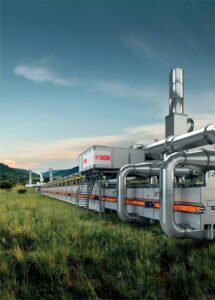
SACMI’S Challenge ZERO-EMISSION CERAMIC KILNS
In the world of ceramics, the name of SACMI is known as the world leader in the supply of advanced technologies for Ceramics and Advanced Materials through continuous development in innovation. The company’s strong positioning on the world market, and its relentless thrive for ensuring high quality standards and customer service is praiseworthy. The Ceramic Industry is focusing on bringing innovative solutions and effective alternatives of traditional machineries through research. The company is focused on working for development of alternative fuels, digitisation and heat recovery aimed at zeroing or reducing consumption in other stages of the process. These are the three pillars of the modern approach to ceramic kiln design, which SACMI recently presented to the market with the first prototype of a 100 per cent hydrogen-fired kiln. The presentation was made during the ‘open week’ organised by SACMI, which took place at the same time as the CERSAIE trade fair. Over 400 international customers of 90 delegations from 35 countries visited the fair. “Making ceramic manufacturing more sustainable is the primary challenge that SACMI has been pursuing for years, implementing optimisations and innovations in all areas of the plant, from forming to firing,” explained SACMI President Paolo Mongardi. Firstly, the kiln accounts for a good 37 per cent of total factory emissions, 46 per cent if one considers all thermal processes (kiln and drier). “With the FMH Maestro, we developed the world’s first industrial kiln fired using up to 50 per cent hydrogen. Today we are taking a further step towards what will be a potentially zero-emission kiln.” The prototype is ready and will be tested to make actual products in the coming months. Meanwhile, the market is moving towards new machines with the full digital management of all parameters in order to optimise quality and consumption. The project The prototype kiln implemented by SACMI is capable of working with variable mixtures of methane and hydrogen – in any percentage – and up to 100 per cent pure hydrogen. The kiln will be ‘switched on’ over the next few weeks, to test its effect on actual products and to take on significant technological challenges, such as the fact that hydrogen has a different calorific value compared to methane and the corrections necessary for managing the firing curves and material feed. From this point of view, the digital control of parameters (e.g. oxygen content at every point in the process) is the prerequisite of this development and has already been implemented in the ‘Maestro’ range of kilns, starting from the FMD model, introduced by SACMI in 2022. The fuel The pure hydrogen production and storage station has already been inaugurated at the SACMI Forni and Filters site in Salvaterra di Casalgrande. The facility, one of the first of its kind in Italy, consists of an electrolyser where hydrogen is produced at a rate of 20 Nm‑ per hour. It is then compressed to increase the outlet pressure from 8/12 bar to approximately 200 bar. This is essential in order to make storage easier, since one of the ‘defects’ of hydrogen is that it is very voluminous (much more so than methane/LPG and up to seven times more voluminous for the same calorific value). The third and last station involves its storage in cylinders, which for the prototype that will be tested in the Lab, “is equivalent to an operating autonomy of 2.5 days” – underlines Daniele Baldini, product manager at Kilns and Driers BU Tiles, SACMI – “sufficient for carrying out full testing on the products”. The advantages Currently, SACMI’s best-selling kiln globally is the modulated air-gas FMA model, which allows air and fuel mixtures to be optimised at every stage, optimising consumption and with great advantages in terms of product quality (especially for complex products, such as slabs), repeatability and consistency of the process. More and more customers are moving towards the latest FMD models (with digital firing parameter and recipe management) and FMH models (already designed for use with methane-hydrogen mixtures of up to 50 per cent). What are the real advantages of ‘full hydrogen’? You just have to consider that by adding 50 per cent clean hydrogen to the mixture, the total saving on CO2 emissions is as much as 23 per cent. This would increase to 55 per cent (more than double) if the mixture were 80 per cent H2 + 20 per cent methane. “What remains constant is the amount of energy required for the process,” notes Baldini, adding, “while to obtain the same amount of energy, a larger volume of hydrogen is required as its calorific value is lower than that of methane (2560 kcal/m3 compared to 8600 kcal); Hence more than proportional savings in emissions to the increase in the amount of hydrogen in the mixture”. This is why it makes sense to increase the hydrogen in the mixture and to get ready for the evolution of the infrastructure, which in all probability will lead to hydrogen-methane ‘blends’ being supplied in increasing but variable amounts. “From this point of view, the way forward already appears to have been decided,” says Claudio Ricci, Tiles R&D Coordinator, BU Tiles, SACMI. “So technology suppliers around the world are getting ready for this development, without forgetting the two conditions which make this scenario viable and truly beneficial to the environment.” First, hydrogen has to be obtained from renewable sources (or rather the electricity needed for the electrolysis process has to be). Secondly, in order for it to be actually applied on an industrial level, the problem of storage has to be overcome (the laboratory prototype is one thing; in a ‘real’ kiln the system would have to be powered directly from the supply network). The 100 per cent H2 kiln is the main but not the only development at SACMI. “By 2024 we will also present a new prototype for an all-electric kiln, exploring all the opportunities in this area as well, with the aim of being ready for the evolution of the infrastructure and
Read More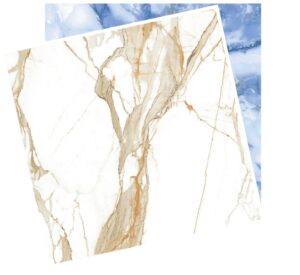
Made More Spacious with Sheltech 1m x 1m Tiles
Sheltech has entered the ceramics market recently with their premium wall and floor tiles. The ceramic newcomer has been performing outstandingly in the industry with various tiles segments of different shapes and sizes, and designs. Sheltech, a 35-year-old group of industries, initially deep-rooted itself in the real estate industry. Sheltech Ceramics Limited recently launched a venture of Sheltech group, initiated in February 2019. The factory has been set up in Bhola, spread on 57 acres of land. Sheltech Ceramics has added production lines and increased production capacity to 420,000 square feet of tiles daily. This recent investment will potentially turn the company into one of the largest manufacturers in the tiles segment. In May 2022, S heltech introduced the largest tiles manufactured in Bangladesh; in other words, it has the first ever locally made 1 meter x 1 meter tiles. Among the three plants that Sheltech Ceramics has in its factory, the third plant was added to manufacture larger sized tiles, premium in quality. The size of such product makes any surface look more spacious, as fewer and thinner grout lines tend to create that impression. The room also feels streamlined when the floors are covered with larger than usual-sized tiles. The 1m × 1m tiles have a thickness of 12 mm and is made with eco-friendly materials resistant to thermal shock. Made to be strong and durable, this series of prime tiles is shiny and attractive, and helps bounce light around. Additionally, it is easy to clean and maintain. There are imported tiles that are similar to Sheltech Ceramics’ 1m × 1m, but they are imported as per necessity and costs a fortune. Sheltech Ceramics Ltd intends to shift the demand from imported tiles to domestically made ones, and manufacture a quality product within the price range of usual customers-henceforth started the manufacturing of the 1m × 1m tiles. An experiment conducted, and the research paper authored, by Jack Nasar, a professor from Ohio State University, and Saleheh Bokharaei (faculty at Shahid Beheshti University, Iran), on Perceived Spaciousness: Altering the six variable factors (VF) that directly effect perceived spaciousness, we can alter how roomy an office room or a bed room looks. The most obvious VF, size, is directly proportional to spaciousness; bigger size means more space. Light is a crucial second, followed by window size. Texture and wall murals are the fourth and fifth, any and all furniture being the last of the six, yet not the least. If you played around with the six variables, you can create different ambiances. The 2016 experiment by Jack and Saleheh had participants rating spaciousness and preference after being exposed to a space via virtual reality. Written by Chisty Rahim
Read More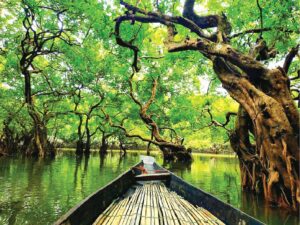
RATARGUL Gowain’s Serene
Only a decade back, when considering a trip to Sylhet, most would think about visiting the lush green heavens of tea tree leaves at the wavy hills of century-old tea estates and the waterfalls. However, over the years, a freshwater swamp forest that flows through the arteries of Gowainghat, has cemented its place in the hearts of thousands of tourists who flocks there every season. It is the only swamp forest of sweet water in Bangladesh. The mighty Meghalaya pours into the Gowain, and a stream flows through the Chengi canal, flooding the entire region under 20-30 feet of water where serenely rests Ratargul with mysticism. Ratargul has an addictive aura. It is one of those spaces where one has to be physically present and let themselves be entirely engulfed by its charm to feel its truest essence. And Ratargul in monsoon, is impossible to encapsulate with words. Water lilies, both white and pink varieties, are a common sight, adding a soothing touch to the landscape. These floating plants not only enhance the beauty of the forest but also provide essential habitat and food for various aquatic creatures. One will also notice slender and tall cypress trees rise majestically from the water, creating a picturesque backdrop. There are numerous other kinds of tress, and once in a while you might be welcomed by monkeys hanging from them or birds singing back to the boatmen. These trees not only offer shelter to numerous bird species but also contribute to the overall biodiversity of the forest. Swamp Forest The moist and humid conditions of Ratargul support the growth of mosses and ferns too. They cover the rocks and tree trunks. Reaching Ratargul requires careful planning, as it is situated in a remote area. Here’s how to get there: By Air: The nearest major airport to Ratargul is Osmani International Airport in Sylhet. From the airport, you can hire a taxi or take a bus to reach Ratargul. By Road: You can reach Ratargul by road from Sylhet city. The journey takes 1.5-2 hours, and you can hire a taxi or use public transportation. Local Transport: Once you reach the nearest village, Gowainghat, you’ll need to hire a local guide or a boat to navigate through the water channels that lead to Ratargul. The boat ride is an integral part of the Ratargul experience, offering stunning views of the surrounding landscape. While Ratargul itself is typically a day-trip destination, you can find accommodation in nearby areas for a comfortable stay during your visit. The beautiful Sylhet city offers a wide range of accommodation options, including hotels, guesthouses, and resorts. It’s a convenient base for exploring other attractions in the region as well. Furthermore, the nearest town to Ratargul is Gowainghat, where you can find guesthouses and lodges. There are eco-resorts for a unique and eco-friendly experience, consider staying in one of the eco-resorts that have been established near Ratargul. These accommodations are often designed to blend seamlessly with the natural surroundings, providing a rustic yet comfortable experience. While planning your visit, remember to adhere to responsible tourism practices to protect this fragile ecosystem for future generations. A visit to Ratargul promises to be an unforgettable journey into the heart of nature’s wonders. Ratargul invites you to be its guest, offering a chance to escape the hustle and bustle of daily life and reconnect with the natural world. We must respect the regulations in place, support local communities, and engage with local guides who can deepen our understanding of this unique ecosystem. By doing so, we not only enhance our own experience but also contribute to conservation efforts that ensure Ratargul remains a pristine sanctuary for generations to come. It’s more than just a tourist destination – a testament to the exquisite beauty and resilience of the natural world. It is a place where you can find solace, inspiration, and a profound connection to the environment. Let’s also ensure that Ratargul’s magic endures for all to experience and cherish.
Read More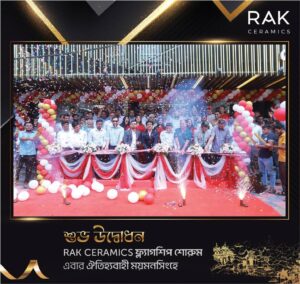
Events Of Ceramic Industry
Inauguration of “Selections” second outlet in Sylhet: Recently AkijBashir Group’s brands emporium “Selections” has opened a new showroom in Hadi Mansion, Pathantula, Sylhet. With the motto – “Select from the best”, the “Selections” brand was launched in October of last year in an aim to provide customers with a one-stop-ground for all of AkijBashir Group’s brand products under one roof with a vast array of ceramic tiles, boards, doors, sanitaryware, bathware and tableware. Inauguration of Flagship Showroom in Mymensing: RAK Ceramics inaugrated their Flagship Showroom in Kalibari Road, Mymensing. Get your desired RAK Tiles & Sanitarywares from the Showroom to decorate your space newly. Fresh Ceramics Organizes Dealer Tour in Thailand Meghna Ceramics Industries Ltd. (MCIL), a concern of Meghna Group of Industries (MGI), has earned the trust of Bangladeshi customers within a short time since its start in 2021. As a continuation to that success, a special dealer tour titled ‘Cutting the Edge’ was organized at Pattaya & Bangkok in Thailand during September 27- October 01, 2023. New ‘Robusto’ Floor Tiles Make a Splash in the Domestic Tiles Market An international quality tiles brand ‘Robusto’ has been added to the local market. Manufactured by the reputable company X-Ceramics, the ‘Robusto’ brand has entered the floor tiles market with a strong commitment to quality. X-Ceramics embarked on the journey to produce ‘Robusto’ floor tiles after more than two years of meticulous research. These tiles are versatile, finding applications in homes, offices, shopping malls, and factories.
Read More

